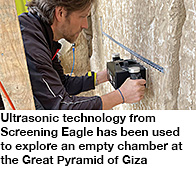Researchers explore chamber at Great Pyramid of Giza using Screening Eagle ultrasonics
15/05/2023
Screening Eagle’s ultrasonic inspection technologies and software have recently been used by scientists from the Technical University of Munich (TUM), Munich, Germany, as part of an international research project at the Great Pyramid of Giza, Egypt, helping them to make significant findings.
The project was in collaboration with the international research team ScanPyramids and aimed to confirm an unknown chamber in the pyramid that was first suspected from measurements that were taken in 2016, but it was not proven until now. As one of the seven wonders of the ancient world, the Cheops pyramid is the largest and the oldest pyramid of Giza and is considered to be one of the best-studied structures in the world. However, thanks to modern technologies, the research team was able to uncover a new mystery: an empty chamber located above the original entrance to the pyramid.
As the Great Pyramid of Giza is part of the World Heritage Site, special care had to be taken during the investigation to ensure that no damage occurred. Therefore, the team used several non-destructive testing methods, including Pundit ultrasonic testing equipment from Screening Eagle.
With the Pundit ultrasonic inspection solution and Pundit Vision data post-processing software, the scientists at the Technical University of Munich were able to gain clear visualisations of the suspected cavity and confirm the initial measurements. The team then used endoscopic cameras to go inside of the chamber through a small gap between the stones of the chevron ceiling and discovered that the chamber is large enough to accommodate several people.
The new findings on such an extensively studied structure highlight the need for further exploration of all of the ancient pyramids. Modern technologies such as the Pundit PD8050 offer non-invasive deep data capture and instant visualisation in 3D
that are ideal for such investigations.
Technologies from Screening Eagle have often been used in major research and archaeological projects, including the investigation of King Tutankhamun’s tomb and locating the first tomb of Christopher Columbus.
